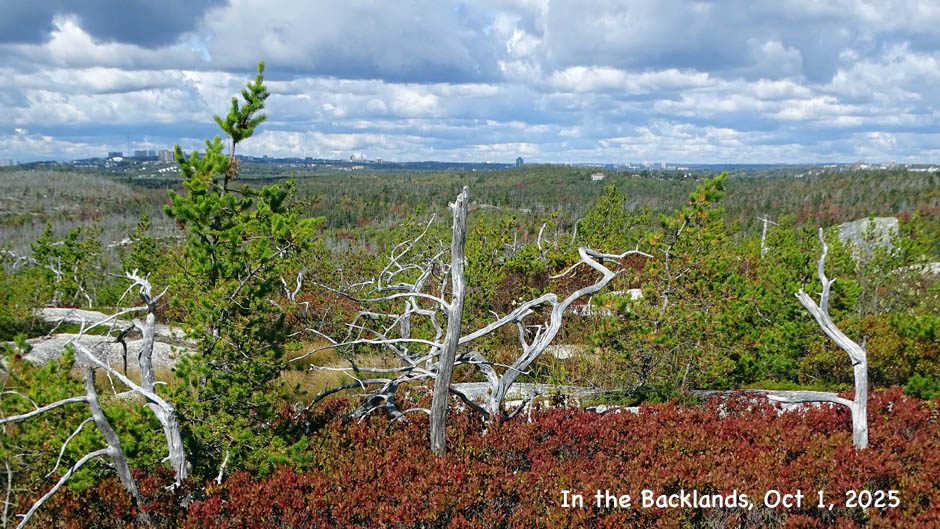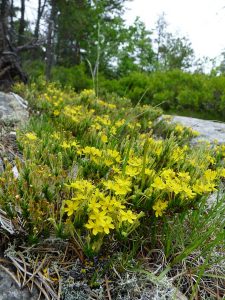And some thoughts about what’s involved in keeping it around.
By David Patriquin
I have been observing Golden Heather (Hudsonia ericoides ) in flower in the Backlands over the last last 10 days or so. Golden Heather is hard to miss when it’s flowering, but otherwise it is not particularly noticeable and the vegetative plant is superficially similar to Broom Crowberry (see links below to botanical descriptions).
Aside from providing attractive flashes of gold on the more exposed areas of the barrens, Golden Heather has an “S-Rank”of 2 (Imperiled) on the ACCDC Conservation Ranks List for NS vascular plants (Link) and thus is a “Priority Species” in NS Environmental Assessments. )*
* A subset of species with S3, S2 and S3 ranks are protected under Nova Scotia’s Endangered Species Act and are formally protected. Species with S-Ranks 1, 2 or 3 but not not listed under the Endangered Species Act could eventually be put on that list (or not) – most of these many ‘candidate species’ have simply not been formally assessed. Such species are generally afforded some consideration/protection in EAs and related processes.

An unusually late flowering Mountain Sandwort found on the barrens Nov 5, 2022 by Joshua Barss Donham. View post
In our study of the Williams Lake Backlands (now the Shaw Wilderness Park), Nick Hill and I found three species with S Ranks of 3 or less (S3=Vulnerable, S2=Imperilled, S1 = Critically Imperilled). (See p12 in our report). The two besides Golden Heather are Mountain Sandwort (Minuartia groenlandica, S2) and Burnt Sedge (Carex adusta, S3/S2).
All were found on recently burnt Jack Pine-Crowberry barrens, underscoring the special conservation value of these communities and their dependence on recurrent fire. Most prominent in these communities are the highly fire adapted Jack Pine (S4) and Broom Crowberry (S4); each on their own are not Priority Species in Nova Scotia, but in combination as the “Jack Pine-Broom Crowberry barrens” (or for short, “JP-Crowberry barrens”) constitute a “Nationally Unique Globally Rare” plant association:*
The combination of Jack Pine, an iconic boreal species, and broom crowberry, an Atlantic Coastal Plain dwarf shrub of the heather family, is found within Canada only on scattered rocky outcrops near the Atlantic coast of Nova Scotia. It occurs only sparingly in similar habitats in Maine, where it overlaps with the globally rare Pitch Pine/Broom Crowberry association. Nova Scotia’s Jack Pine/Broom Crowberry Barrens are likewise globally rare. From Hill and Patriquin 2014, p 74; see also Appendix C in that document (“Jack Pine/Broom Crowberry Barrens: their occurrence and status as a recognized plant association”).
In most places in Maine where Jack Pine and Broom Crowberry have occurred together in the past, Jack Pine has been replaced by the more warm-temperature-tolerant Pitch Pine.
*Nova Scotia is the only jurisdiction in which Broom Crowberry is “Apparently Secure” (S4); in other jurisdictions where it occurs it has S3, S2 or S1 status (See NatureServe Map). Unfortunately we have lost 97% of its sand barrens habitat in the Annapolis Valley to settlement and agriculture, and the rock barrens of the Atlantic coast continue to be lost to development.
Our JP-Crowberry barrens are restricted to scattered outcrops along the Atlantic coast from the Aspotogan Peninsula to Canso, the Backlands amongst them. While rare plant associations are not formally recognized or protected in NS*, the conservation value of the JP-Crowberry barrens and their beauty have been recognized by the Nature Conservancy of Canada and by the Nova Scotia Nature Trust in relation to some of their recent land acquisitions in the Backlands and on the Aspotogon Peninsula.
*The equivalent Pitch Pine – Broom Crowberry Association on coastal rocky outcrops in Maine (the “Pitch Pine / Broom Crowberry Woodland”) is considered Globally Imperilled.
Before the 2009 Spryfield fire which torched about 2/3 of the Backlands, Golden Heather was a fairly rare sighting. It is likewise rare and limited to smaller patches in older JP-Crowberry Barrens today but I have seen a lot of it on some of the barrens that burnt in 2009. I followed the early succession of plants after that fire and noted in 2010: “As was the case for broom crowberry, I observed seedlings for the first time only in the late summer of 2010. They seem to get a bit of a jump start over the crowberry, however, as they were much larger than the crowberry seedlings, either germinating earlier (but unseen), and/or growing faster.”* More recently I have observed the slower spreading Broom Crowberry begin to grow over and start to displace some of the Golden Heather. So the relative high abundance we see of Golden Heather now is probably transient. These are very dynamic communities.
*See Regeneration of Forest and Barrens after the Spryfield Fire of April 30, 2009
In my view, If we want to keep the suite of species associated with our JP-Crowberry barrens around and avoid a recurrence of really massive fires (as in 2009), we need to develop a combined Fire Management/Conservation strategy for the Backlands. It would be timely to do so given the new attention to such matters following our worst wildfire year provincially and nationally, not yet over.
Links
1. On fires, fire ecology and fire management in the Backlands:
– Natural History/Overviews/Fire Ecology
Page on this website
– Fire-scarred white pines are a reminder that it’s Fire Season – especially in the Backlands (Halifax, NS) 19May2023
Post on this website May 19, 2023
2. To distinguish between the low growing heath-like species in our Backlands and on nearby coastal lands, view these species descriptions on the old (archived) NS Wild Flora website:
– Corema conradii (Broom Crowberry)
– Empetrum nigrum (Black Crowberry)
– Empetrum eamesii (Rockberry)
The 3 crowberries above can be difficult to distinguish when they are not flowering or with berries. All 3 species are found on coastal barrens (e.g. as in the Peggy’s Cove area), but to date, only Broom Crowberry has been found in the Backlands. Golden Heather (below) is found on both the coastal barrens and the Backlands; it may appear superficially like the Crowberries, but is readily distinguished when examined up-close.
– Hudsonia ericoides (Golden heather)


